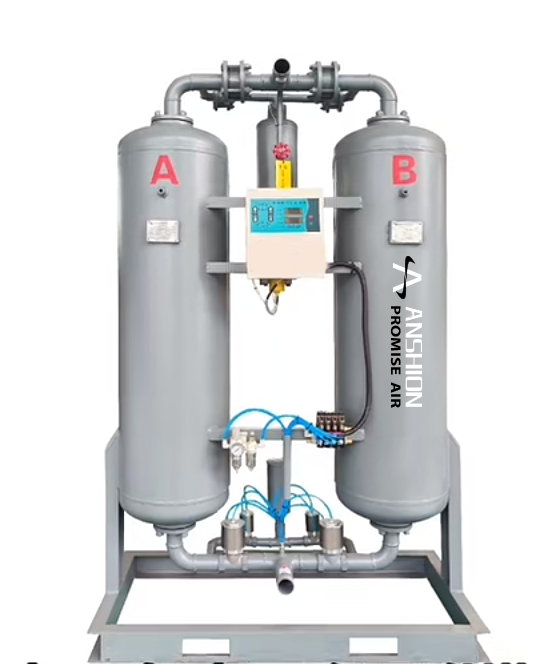2024/12/10 11:10:48
Resources
Working Process of Adsorption Dryer
Overview of adsorption dryer
The adsorption dryer mainly uses adsorbents
(such as activated alumina, molecular sieves, etc.) to adsorb moisture in humid
air to obtain dry air. It usually adopts a double-tower structure, that is, the
two drying tanks A and B are filled with adsorbents respectively, and
continuous air drying is achieved by alternating work.
Detailed explanation of the work process
1. Adsorption stage
During the adsorption stage, humid air
enters the A drying tank (or B drying tank, depending on the current working
status) through the air inlet valve. The humid air enters from the lower pipe
system and passes through the adsorbent bed from bottom to top. The adsorbent
has extremely strong hydrophilicity and can adsorb moisture in the humid air to
obtain dry air. The dried air is discharged from the upper pipeline for
subsequent use.
During the adsorption process, the
following points should be noted:
• Inlet pressure and temperature: The air
inlet pressure should be controlled within a certain range, usually not
exceeding 1MPa, and the inlet temperature should also be kept within the
specified value to ensure the adsorption effect.
• Adsorbent saturation: As the adsorption
time increases, the saturation of the adsorbent will gradually increase. When
the adsorbent reaches saturation, its adsorption capacity will drop
significantly, and it needs to be regenerated in time.
2. Regeneration stage
The regeneration stage is a key link in the
work process of the adsorption dryer. During the regeneration stage, part of
the dry air (usually about 10%) enters the B drying tank (or A drying tank,
opposite to the adsorption stage) through the upper pipe system regeneration
gas regulating valve. This part of the air is called "regeneration
gas".
After the regeneration gas enters the B
drying tank, the adsorbent is purged from top to bottom to remove the moisture
and impurities adsorbed in the adsorbent. The decompressed dry air (i.e.,
regeneration gas) gradually heats up during the purge process, further
improving the regeneration effect. The regenerated regeneration gas is
discharged into the atmosphere through the lower pipe system B2 valve and
muffler.
During the regeneration process, the
following points should be noted:
• Regeneration gas volume: The size of the
regeneration gas volume directly affects the regeneration effect. Too small a
regeneration gas volume may lead to insufficient regeneration, while too large
a regeneration gas volume may waste energy.
• Regeneration temperature: The
regeneration temperature is an important factor affecting the regeneration
effect. Appropriate regeneration temperature can accelerate the desorption
process of moisture in the adsorbent and improve the regeneration efficiency.
• Regeneration time: The length of the
regeneration time should be flexibly adjusted according to the saturation of
the adsorbent and the regeneration effect.
3. Pressure equalization stage
The pressure equalization stage is carried
out after the regeneration stage. During the pressure equalization stage, the
B2 valve is closed and the B drying tank begins to increase the pressure to the
online pressure, which is consistent with the working pressure of the
adsorption stage. The purpose of the pressure equalization process is to
balance the pressure in the B drying tank with the working pressure of the
adsorption stage to prepare for the subsequent switching stage.
The pressure equalization process is
usually faster, but it is also necessary to ensure the stability of the
pressure balance. If the pressure equalization is insufficient or unstable, it
may cause pressure fluctuations during the switching process and affect the
drying effect.
4. Switching stage
The switching stage is the last link in the
workflow of the adsorption dryer. During the switching phase, the B1 valve of
the lower pipe system is opened, the A1 valve is closed, and the A2 valve is
opened at the same time. In this way, the A and B drying tanks are switched:
the B tank enters the adsorption phase and begins to adsorb moisture from the
humid air; while the A tank enters the pressure relief regeneration phase and
prepares for the next regeneration process.
The switching process needs to be carried
out quickly and accurately to ensure the continuous and stable operation of the
dryer. At the same time, the pressure fluctuation during the switching process
also needs to be controlled within a certain range to avoid damage to the
equipment or affect the drying effect.
